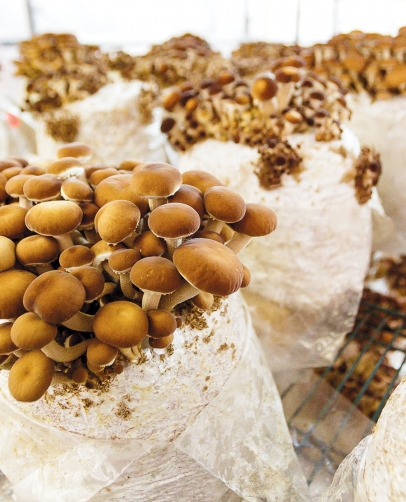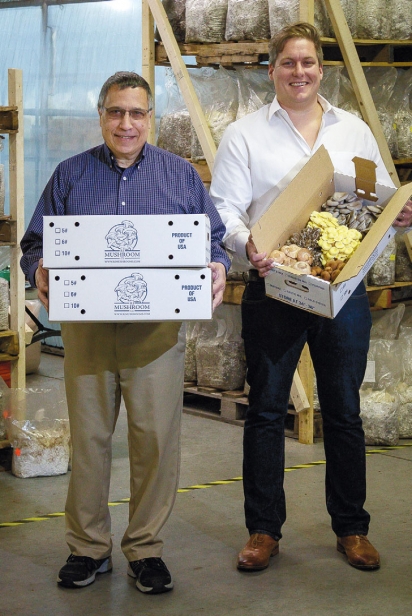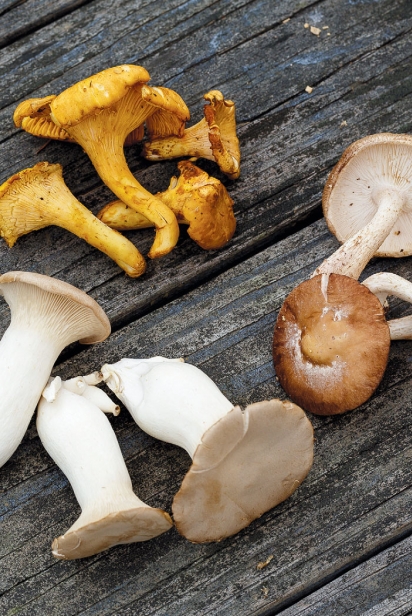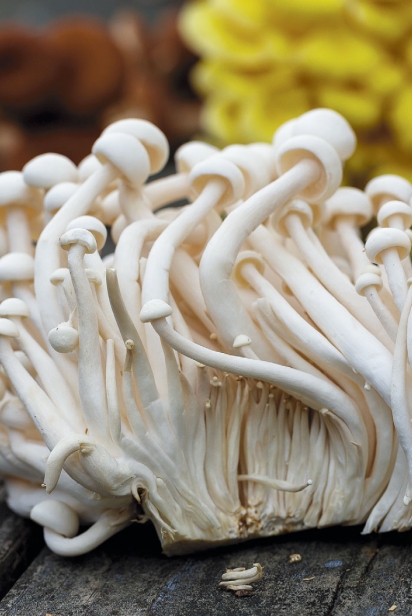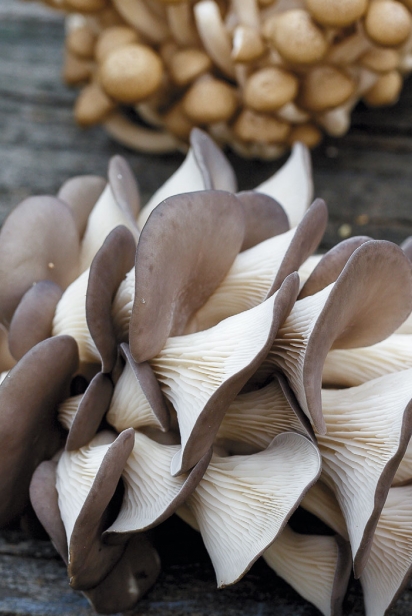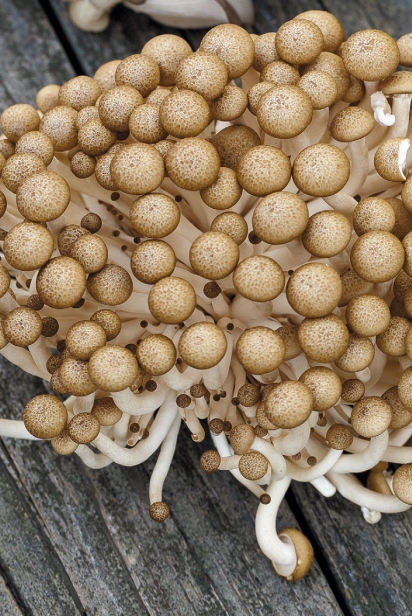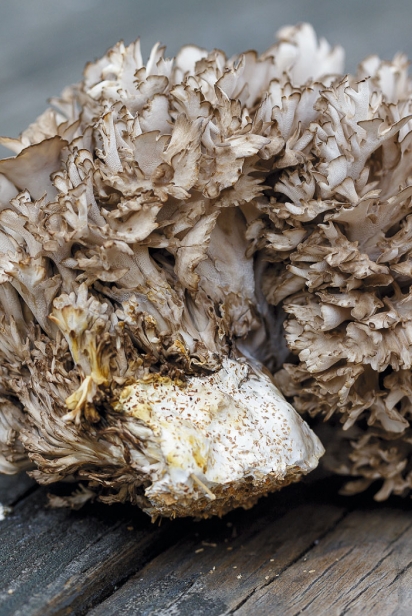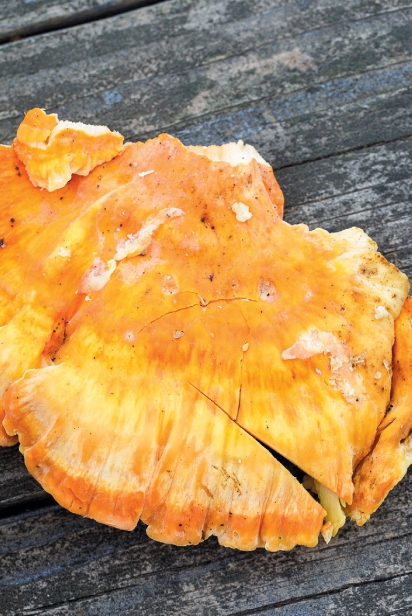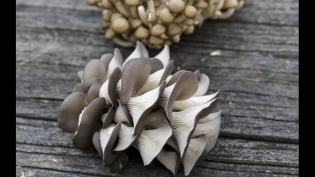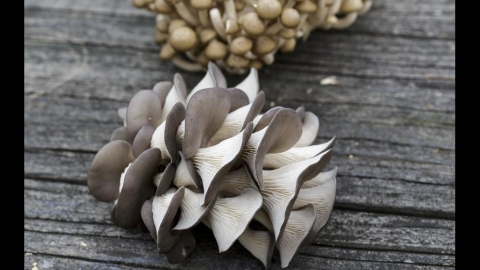Cultivating a Following for Fungi
RI Mushroom Co. Takes Their Locally Grown Product Beyond the Borders
As we don hairnets to enter the first greenhouse (and I note a sign that beard nets must also be worn), I realize the truly serious nature of growing mushrooms. Bob DiPietro and Mike Hallock, co-owners of the RI Mushroom Co., are giving me a tour of their “farm” in West Kingston. Housed inside an expansive warehouse, the company has three greenhouses, a laboratory, two large walk-in coolers for the harvested product and many other sections set aside for the work of being both mushroom growers and purveyors.
We step inside the cool, damp air of the first 16- by 50-foot greenhouse and I take in the tall metal shelves lined with blocks of growing medium: a mixture of sawdust, cottonseed hulls and brewery “waste” from next-door neighbor Proclamation Ale.
The blocks are in clear plastic bags so the spidery white mycelium threads running through the “soil” of each block are the first things that catch my eye. Where slits have been made in the plastic, mushrooms are starting to push through, to form, in some cases, familiar nut brown caps and in other cases, almost Alice-in-Wonderland colors and shapes: small bright yellow caps, blue-gray curving fungal surfaces, light beige frilly-edged fans.
These are the homegrown, cultivated versions of wild mushrooms such as pioppino, golden oysters, blue oysters and maitakes (or hen-of-the-woods, also called signorina by Italian-Americans in Rhode Island). The mushrooms are the fruits of the fungi and the mycelium is the vegetative part that is usually hidden underground.
All of the mushrooms are raised in incredibly controlled conditions for purity (thus the hairnets), with computers constantly checking on temperature, humidity, airflow and light. The humidity is kept at 95% and the airflow is changed 12 to 14 times an hour, partly because the mushrooms give off CO2, the opposite of plants but the same as humans and other animals.
One other thing about growing mushrooms in a greenhouse is that DePietro and Hallock (and their 13 employees) must keep the golden oysters separated from the blue ones. According to Hallock, “They sense the competition and throw out more spores!” And when that happens, the blue oysters just stop growing, because there are too many competing spores in the air.
Hallock and DiPietro met when Hallock was working for Farming Turtles (a greenhouse farm in Exeter) growing shiitakes. It was there that he discovered his love of mushrooms.
“I just loved the science behind it,” he says enthusiastically. “I like creating the environment, figuring out the electrification, the humidity—the whole thing.”
He also loves trying out new strains of the same species, to see if they grow bigger or faster or are more consistent. I follow him and DiPietro into their purified “lab” room, a small chilly space with coolers that hold petri dishes of mushroom spawn that are growing into the white mycelium I’d just seen in the greenhouses. Once there is enough mycelium, it gets “planted” into organic rye before it’s transferred to its growing medium in the plastic bags. It takes approximately eight to 10 weeks for blue oysters to grow from petri dish to produce.
Back in their shared office, DiPietro and Hallock fill me in on their backgrounds. Hallock is a guitarist who still performs with a live electronic band called Wobble Sauce. But once he and DiPietro dreamed up their mushroom enterprise, he has also been a dedicated mushroom farmer, from breeding ’em to eating ’em.
DiPietro’s roots are in the restaurant world, where he worked for 30 years. So after he and Hallock started growing mushrooms at Sweet Berry Farm in Middletown in 2013, some of their first sales were to Newport and Providence restaurants. He also knocked on doors in New York City to create a market for the previously little-known pioppinos, very popular in Italy. They now sell most of their pioppinos to upscale chefs in Manhattan. They also sell to restaurants from Mystic to Providence; to 69 Whole Foods markets; to a halfdozen Rhode Island farmers’ markets and specialty markets. And each package that goes out has their RI Mushroom Co. logo stamped on the sides.
DiPietro mentions the uptick in interest in mushrooms: There are clinical trials all over the world concerning the health effects, now specifically looking at which mushrooms attack which tumors, how they stimulate the immune system, what dose works with which disease. He also explains that mushrooms can help in bio-remediation: If land is soaked in oil, for example, and then mycelium is introduced, it will metabolize the hydrocarbons and clean up the soil.
These RI Mushroom guys don’t grow all the mushrooms they sell; they have trusted mushroom farmers in Pennsylvania who help them keep up with the demand—the space it would take to grow crimini and portabellos wouldn’t be profitable for them, so, Hallock says, “We make sure we get the best stuff, a very high-end product.” The same is true for the wild foragers they buy from, in Europe and across the U.S. and Canada, primarily for morels and chanterelles.
And they created some unique savory items to sell at local farmers’ markets. From “leftover mushrooms,” they collaborated with chef Steve Cory, of Cory’s Kitchen, to create five kinds of tomato sauce: mushroom Fra Diavolo, a Romesco sauce with grated almonds, Provençal or Moroccan simmer sauces, and a roasted mushroom ragout.
From their restaurant and farm backgrounds, both DiPietro and Hallock love to cook. They can’t say enough about the layers of flavor in the pioppino mushrooms—Hallock admits to letting his toddler scarf down a pound of them. They post recipes on their website and on Facebook, and they’re always trying something new. Hallock touts roasting maitakes with carrots or Brussels sprouts.
“Ah,” says DiPietro, “the sweetness plays against the earthiness.”
“Have you tried just cutting the pioppinos into quarters, sautéeing them with butter and then putting greens of some kind on top to cook?” DiPietro counters. “Over pasta—supreme!” Hallock reminds him that he doesn’t eat much pasta but he could have those on the side with a steak. Or what about putting some white wine and shallots in with the pioppinos?
Do the maitakes give off a woodsy smell as they cook, they wonder. Do the blue oysters taste meaty in a stew? And how would you describe the taste of the rich, decadent pioppinos?
I pick up my “chef’s mix” of five different mushrooms, eager to try roasting the maitakes, and head for the door. As I leave these two fungi-philes to their busy day, they are still excitedly sharing their newest mushroom recipes.
Visit RI Mushroom Co. at RIMushrooms.com and look for them at local farmers’ markets and groceries and on menus around the state.
Cooking with Mushrooms
Generally speaking, people tend to vastly undercook mushrooms, missing out on their rich flavor and texture. Don’t be afraid to sear them in extra-virgin olive oil on high heat until they brown and caramelize.
Mushrooms lend themselves well to many types of preparations, from a simple sauté to soups and stews. A modest but satisfying dish is to pair seared mushrooms with egg noodles, adding a pat of butter at the end to enrich the flavor.
Maitake Mushrooms Shred lengthwise and sauté in extra-virgin olive oil, adding a touch of garlic, herbs and salt at the end. Or, break mushrooms into florets, drizzle with oil and bake on a sheet pan for 30 minutes at 400° (turning over halfway through) until golden brown.
Blue or Golden Oyster Mushrooms Slice off the caps and set aside. Thinly slice the base and stems. First sauté the base and stems in extra-virgin olive oil until they begin to brown, and then add caps. Finish with chopped garlic and fresh herbs (I like tarragon or thyme).
Pioppino Mushrooms Cut off caps and set aside. Thinly slice the stems on the bias and sauté in extra-virgin olive oil until they begin to brown. Add caps and ½ cup stock of your choice (such as chicken or vegetable) and cook over low heat until liquid evaporates. Flavor as above with garlic and herbs.
—From Bob DiPietro, RI Mushroom Co.


